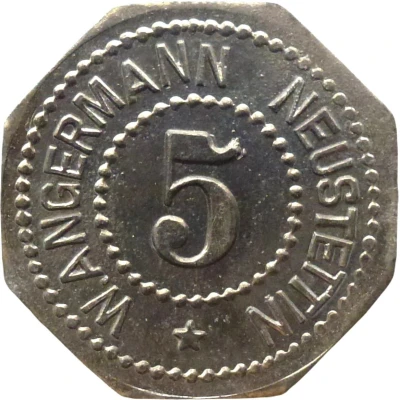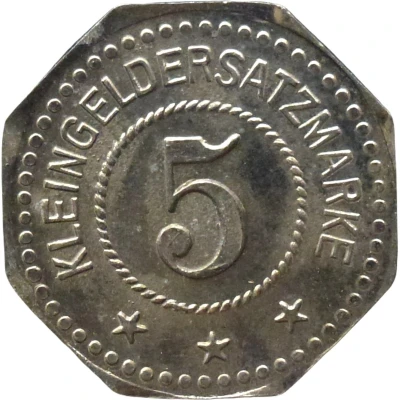


© Willem63 (CC BY-NC-SA)
5 Pfennigs - Neustettin (W. Angermann) ND
| Nickel plated zinc | 1.6 g | 19.3 mm |
| Issuer | City of Neustettin (Prussian province of Pomerania) |
|---|---|
| Type | Standard circulation coin |
| Value | 5 Pfennigs (5 Pfennige) (0.05) |
| Currency | Mark (1914-1924) |
| Composition | Nickel plated zinc |
| Weight | 1.6 g |
| Diameter | 19.3 mm |
| Thickness | 1.0 mm |
| Shape | Octagonal (8-sided) |
| Technique | Milled |
| Orientation | Medal alignment ↑↑ |
| Demonetized | Yes |
| Updated | 2024-10-04 |
| Numista | N#343957 |
|---|---|
| Rarity index | 95% |
Reverse
Pearl rim, legend surrounding rope circle with denomination centered
Script: Latin
Lettering:
KLEINGELDERSATZMARKE
5
★ ★ ★
Edge
Plain
Comment
Menzel: BBBFa.: Brutapparatefabrik (Incubators factory)
Interesting fact
The 5 Pfennigs coin from Neustettin (Prussian province of Pomerania) made of Nickel plated zinc weighing 1.6 g is interesting because it was issued during a time when the use of nickel-plated zinc was a new and innovative approach in coin production. This coin, issued in the late 19th century, features a unique combination of materials that was not commonly used in coinage at that time. The use of nickel-plated zinc allowed for a more durable and resistant coin that could withstand the wear and tear of circulation, while also providing a more affordable alternative to traditional metals like silver and gold. This coin is a prime example of how coinage has evolved over time, incorporating new technologies and materials to meet the needs of a changing world.